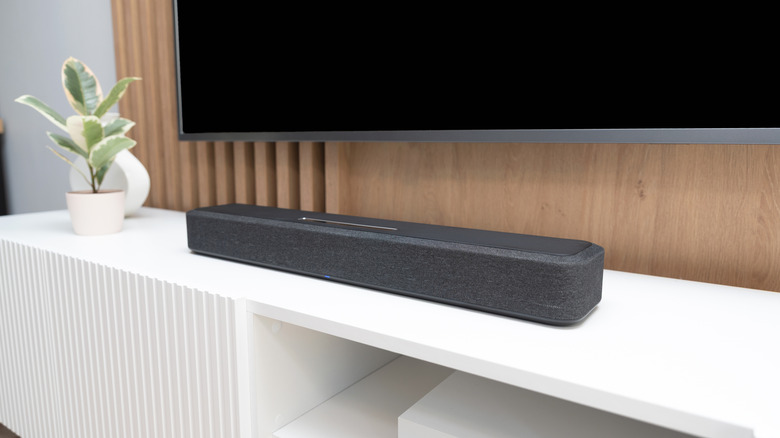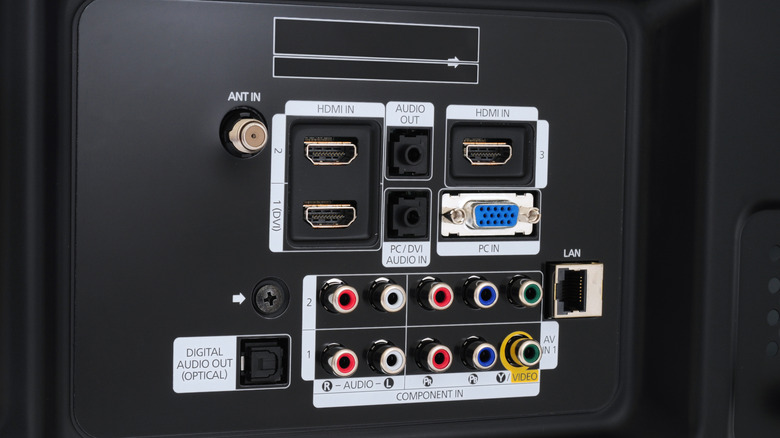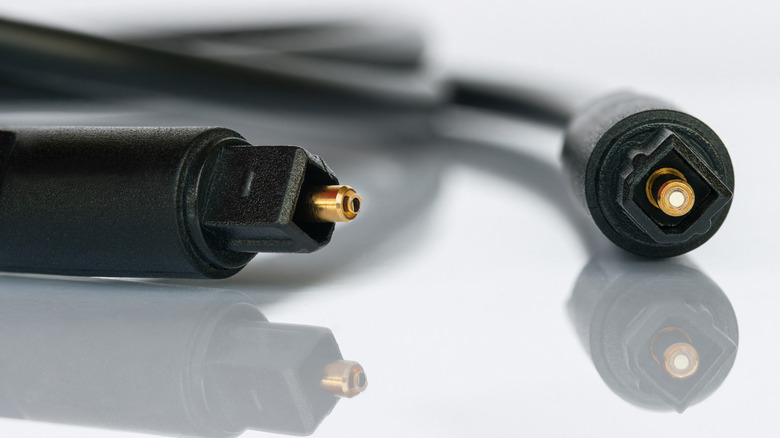Should You Use The TV's HDMI eARC Port For Your Soundbar And Is It Better Than Optical?
Once you've picked out a nice smart TV with a good OS and a quality sound system to go with it, you'll already have two of the biggest decisions for setting up your home theater out of the way. There are a handful of other gadgets that can make home entertainment even better, but these two are more than enough to get you started. All you need to do is take them home, pop open the boxes, and set them up. That might sound easy enough, but there are a few decisions you can make during this initial setup process that can dramatically affect the sound quality you get any time you use the TV.
One of the biggest of these decisions is whether or not to use the eARC Port on your TV to connect your sound system instead of the optical port. You might not think that there's that much difference between the two, since they are both designed to make sound travel from your TV to your speakers, but there are some essential distinctions in how these connectivity options function that can have a significant impact on your listening experience. Different types of connections can affect the quality of the sound, the features that you can control from your TV, and the convenience with which you can manage the entire setup when it's time to sit down and watch something. Some options may even unlock certain kinds of advanced surround sound features that wouldn't otherwise be available.
The eARC HDMI port is going to be the best option for the vast majority of users (provided that their TV has one), but to understand why, you'll first need a little more information about what eARC is and what kind of benefits it has over an optical connection.
What is eARC?
eARC stands for Enhanced Audio Return Channel. This connectivity type was first launched in 2017 and has since become a standard option on most newer smart TVs made by major brands. It is the newer and more powerful version of the original ARC connection, which was first introduced in 2009. The port used for the connection looks just like any other HDMI port that you might use for connecting video devices to your TV, but as you might have guessed from the name, it's specifically geared toward audio information transfer. eARC is pretty easy to set up as well. It doesn't require a special cable or anything complicated. All you need is a standard high-speed HDMI 2.1 cable, just like the ones you might use for connecting any other external digital device. In fact, many sound bars and other home theater audio systems will include this as an option in the box.
eARC is designed to send high-quality sound via a digital signal that travels at a rapid speed from your TV to any external audio devices, such as receivers, sound bars, or pod speakers. It's currently considered one of the best commercially available methods for transferring digital audio information, as the high data flow made possible by HDMI makes it possible to enjoy uncompressed audio at exceptionally high bit rates and with minimal latency.
It isn't just about the quality of the raw audio, either. eARC also allows special audio technology systems to pass through it. Both the standard ARC connection and eARC are able to utilize the full functionality of Dolby Atmos, for instance, but only the improved bandwidth available on eARC offers the higher-end Dolby TrueHD and DTS-HD Master Audio.
Comparing eARC to optical
So, now you know a bit more about what eARC is and what it can do, you might be curious to hear a bit more about how the standard optical connection compares to it. Optical might be enough to get the sound to come out of the speakers, but it pales in terms of raw technical specs and performance.
Optical connections are made using a fiber optic cable that has a bandwidth of around 96 kHz. It can support compressed 5.1 surround sound options, such as those offered by Dolby Digital and DTS. Some people have found that it's more stable over longer distances, such as in instances where you need to run a cable from a projector, as optical cables are known to be immune to electrical interference, but that rare situation is likely its only advantage.
eARC can do just about everything that optical can do and more. Its HDMI-based connectivity has an exponentially higher bandwidth, offering up to 48 Mbps, and offers audio formats such as Dolby Digital, Dolby Atmos, Dolby True HD, Master Audio, DTS-HD, and DTS:X. It also supports additional features that optical doesn't, such as lip-sync correction and full CEC control. Some low-end sound bars that don't have any of these features might not see any of the benefits of these functionalities. In those instances, the performance will likely be about the same no matter which of these connectivity options you use. But in most instances, the eARC is going to be the better choice.


